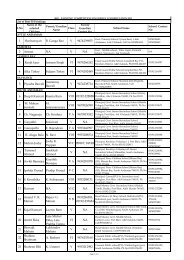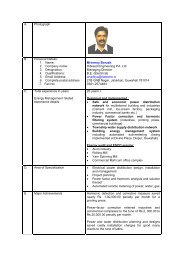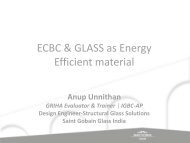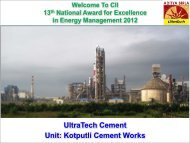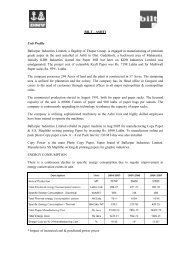ACC Sindri Cement Works Dhanbad - Energy Manager Training
ACC Sindri Cement Works Dhanbad - Energy Manager Training
ACC Sindri Cement Works Dhanbad - Energy Manager Training
You also want an ePaper? Increase the reach of your titles
YUMPU automatically turns print PDFs into web optimized ePapers that Google loves.
Unit Profile<br />
The Associated <strong>Cement</strong> Companies Limited<br />
<strong>Sindri</strong> <strong>Cement</strong> <strong>Works</strong>, <strong>Sindri</strong>, <strong>Dhanbad</strong>, Jharkhand<br />
<strong>Sindri</strong> <strong>Cement</strong> <strong>Works</strong>, a part of The Associated <strong>Cement</strong> Companies Limited, is the manufacturer<br />
of Blended <strong>Cement</strong> (Portland Slag <strong>Cement</strong>) in the name of “<strong>ACC</strong> Super”. The total annual sales<br />
turnover of the works for the financial year 2003-2004 is Rs. 21486 Lakhs. It is situated in <strong>Sindri</strong>,<br />
Dist. <strong>Dhanbad</strong> in Jharkhand state. It is an ISO 9001 & ISO 14001 certified unit. It got ISO 9001<br />
certificate in February 2000 and ISO 14001 certificate in July 2002.<br />
Process Flow Chart<br />
RECEIPT OF BLAST<br />
FURNACE SLAG [WET]<br />
VERTICAL ROLLER<br />
MILL<br />
BLENDING &<br />
STORAGE SILO<br />
PACKING HOUSE<br />
STORAGE SILO<br />
<strong>Energy</strong> Consumption<br />
Ground Slag<br />
Supply of Hot Air<br />
HOT AIR<br />
GENERATOR<br />
CEMENT GRINDING IN<br />
BALL MILLS<br />
ROTARY PACKING<br />
PLANT<br />
Air<br />
Fine Coal Air<br />
Air<br />
RECIEPT OF<br />
RAW COAL<br />
COAL MILL<br />
Hot Air<br />
HOT AIR FURNACE<br />
USING LUMPY COAL<br />
CLINKER & GYPSUM<br />
CEMENT DESPATCH BY<br />
RAILWAY WAGONS &<br />
TRUCKS<br />
There has been a steady decrease in the Electrical <strong>Energy</strong> Consumption over the last few years,<br />
which is very much clear by looking into the graphs given below.
DESCRIPTION UNIT 2001-02 2002-03 2003-04<br />
Annual Production Lakhs Ton 6.47 7.08 7.3<br />
Total Electrical <strong>Energy</strong> Consumption<br />
per annum<br />
Lakhs KWH 348.307 361.667 367.720<br />
Specific<br />
Consumption<br />
Electrical <strong>Energy</strong> KWH/ Ton 53.83 51.08 50.37<br />
YEAR ELECTRICITY CONSUMPTION (KWH/ % REDUCTION OVER<br />
Ton)<br />
2002-03<br />
2002-2003 51.01 --<br />
2003-2004 50.37 1.25<br />
2004-2005 52.71 - 3.33<br />
Gross Power<br />
(KWH/ Ton)<br />
Nonprocess<br />
Power<br />
(KWH/<br />
Ton)<br />
Gross Electrical Power Consumption<br />
53<br />
52.5<br />
52<br />
51.5<br />
51<br />
50.5<br />
50<br />
49.5<br />
49<br />
2002-03 2003-04 2004-05<br />
Financial Year<br />
Non-process Power Consumption<br />
2.5<br />
2.48<br />
2.46<br />
2.44<br />
2.42<br />
2.4<br />
2.38<br />
2.36<br />
2.34<br />
2002-03 2003-04 2004-05<br />
Financial Year<br />
Process<br />
Power<br />
(KWH/<br />
Ton)<br />
Percenta<br />
ge<br />
48<br />
47.5<br />
47<br />
46.5<br />
46<br />
45.5<br />
45<br />
44.5<br />
12<br />
10<br />
44<br />
8<br />
6<br />
4<br />
2<br />
0<br />
Process Power Consumption<br />
2002-03 2003-04 2004-05<br />
Financial Year<br />
<strong>Energy</strong> Cost as % of Manufacturing Cost<br />
2002-03 2003-04 2004-05<br />
Financial Year
<strong>Energy</strong> Conservation Commitment, Policy and Set up<br />
The <strong>ACC</strong> considers <strong>Energy</strong> Saving as a multi – disciplinary approach. Although the company’s<br />
energy profile consists of mainly electrical energy, energy conservation projects still are being<br />
taken exclusively and budget is provided if required.<br />
<strong>Energy</strong> Conservation week is celebrated every year from 14 th December to 21 st December. A<br />
poster, slogan and rangoli competition for children and ladies on energy saving and in – house<br />
programmes for employees are conducted. Suggestions on the energy saving are asked from the<br />
employees and the best ones are handsomely rewarded. One unique activity during this week is<br />
the honoring the housewife of the family having the least power consumption or best power<br />
saving record. The importance of the energy saving is emphasized through various SHE activities<br />
and TPM forum.<br />
<strong>Energy</strong> Management Policy<br />
• Promote & encourage <strong>Energy</strong> Saving & conservation of natural resources.<br />
• Create awareness among all people concerned with organization for <strong>Energy</strong> Saving.<br />
• Encourage involvement through various training programme for conservation of <strong>Energy</strong>.<br />
• Minimize wastage of any kind in daily activities in and around plant & colony.<br />
• To make an effort to reduce the <strong>Energy</strong> cost on continual basis by adopting effective<br />
<strong>Energy</strong> Management.<br />
ENCON Cell Structure<br />
EC Cell is headed by <strong>Manager</strong> Engineering & all the functional heads are member of the EC Cell.<br />
This cell meets everyday to monitor the power consumption pattern of previous day. Apart from<br />
this, monthly power consumption is also reviewed in meeting of all management staffs. This<br />
meeting is held every second Saturday and is chaired by Vice President. Projects evolved out of<br />
theses meetings are executed in the departments by the departmental QC groups. The structure<br />
of the EC Cell is given below.<br />
Unit Head<br />
EC cell headed by <strong>Manager</strong> Engg & all functional heads are<br />
members. Activities are -<br />
• Brainstorming<br />
• Identification of Projects<br />
• Cost Benefit Analysis<br />
• Implementation<br />
• Monitoring of Project Execution<br />
• Monitoring of <strong>Energy</strong> Conservation Trend<br />
Various departmental small groups in the following areas<br />
for implementation of projects<br />
• <strong>Cement</strong> Mills<br />
• VRM<br />
• Packing House<br />
• E&I
<strong>Energy</strong> Conservation Achievements<br />
1. CM3 separator modification<br />
Before modification<br />
• Output - 19 tph<br />
• Sp. Power – 42.1 kWh/Tn OPC<br />
After modification<br />
• Output - 22 tph<br />
• Sp. Power – 36.36 kWh/Tn OPC<br />
Savings: 5.7 kWh/tn OPC, i.e. 2.8<br />
kWh/tn PSC<br />
Net savings = Rs. 63 Lakhs<br />
Investment = Rs. 25 Lakhs<br />
2. Mechanical conveying of OPC<br />
Before modification<br />
• Sp. Power for OPC conveying -<br />
1.6 kWh/tn OPC<br />
After modification<br />
• Sp. Power for OPC conveying -<br />
0.32 kWh/tn OPC<br />
Savings: 1.27 kWh/tn OPC,i.e. 0.63<br />
kWh/tn PSC<br />
Net saving = About Rs. 13.63 Lakhs per<br />
annum<br />
Investment = Rs. 31 Lakhs
3. Replacement of Low efficiency fans of Packing House with High Efficiency fans<br />
Before modification<br />
• Power of Packer fan – 25 kW.<br />
• Power consumption of elevator fan –<br />
13.6<br />
After modification<br />
• Power of Packer fan – 18 kW.<br />
• Power consumption of elevator fan –<br />
8.41<br />
Savings: 0.84 Lakh unit<br />
Net savings = Rs. 2.46 Lakhs per annum<br />
Investment = Rs. 1 Lakhs
Brief write-up about the projects in 2004-05<br />
1. Replacement of old separator of <strong>Cement</strong> Mill 3 with new high efficiency separator.<br />
The efficiency of the earlier separator of <strong>Cement</strong> Mill 3 was very poor. This was the<br />
earlier generation Polysius make Turbo separator, which was having very little control<br />
over fineness & residue. The rpm of such separator can not be varied neither there is any<br />
provision of control of flow. Due to this, it was required to operate the cement mill almost<br />
in open circuit mode with very low velocity through mill in order to maintain quality. As a<br />
result we were loosing in output. At this point, it was decided to replace this old separator<br />
with a new high efficiency dynamic separator so that there is better control on the product<br />
as well as we could operate the mill in close circuit mode with higher mill velocity so that<br />
our output goes up.<br />
After this modification, the product residue has gone down from earlier 35 – 40 % to 25-<br />
26 % on 45 µ. Apart from this improvement in product quality, the output of the mill has<br />
also increased by around 3 tph. As a result there is an annual savings of 2.6 kWh/tn<br />
PSC. Net savings is around Rs. 63 lakhs per annum with an investment of Rs. 25 Lakhs.<br />
2. Mechanical conveying of OPC<br />
The OPC produced in the cement mills were conveyed to the OPC silo pneumatically by<br />
means of D-pump. The power consumption of the pneumatic conveying was to the tune<br />
of 80 kW, which works out to be 1.6 kWh/tn OPC. We had replaced the same with<br />
mechanical conveying system involving belt conveyor & belt bucket elevator. Total<br />
Investment is Rs. 31 lacs. Total savings is to the tune of Rs. 13.63 Lacs per annum.<br />
savings is around Rs. 24 lakhs per annum with an investment of Rs. 1.3 Lakhs.<br />
3. Modification of burner pipe of Hot air generator for consumption of low grade coal<br />
We are using Hot Air Generator (HAG) for generating hot air for use in VRM for slag<br />
drying. As fuel we are using b-grade coal. Whenever we tried lower grade of coal we<br />
faced lot of coating generation problem in HAG. We had replaced the burner with a<br />
modified one with better control of swirling, and after that replacement we are able to<br />
utilize 10% of low grade coal Thus we could save approximately Rs.21.6 Lacs per<br />
annum.
RECEIPT OF BLAST FURNACE SLAG<br />
[WET]<br />
VERTICAL ROLLER MILL<br />
BLENDING & STORAGE<br />
SILO<br />
PACKING HOUSE STORAGE<br />
SILO<br />
Ground Slag<br />
Supply of Hot Air<br />
Air<br />
HOT AIR GENERATOR<br />
CEMENT GRINDING IN BALL<br />
MILLS<br />
Fine Coal Air<br />
Air<br />
RECIEPT OF RAW<br />
COAL<br />
COAL MILL<br />
Hot Air<br />
HOT AIR FURNACE USING LUMPY<br />
COAL<br />
CLINKER & GYPSUM<br />
ROTARY PACKING PLANT CEMENT DESPATCH BY RAILWAY<br />
WAGONS & TRUCKS<br />
Fig: Schematic Diagram showing the Production Process of <strong>Sindri</strong> <strong>Cement</strong> <strong>Works</strong>


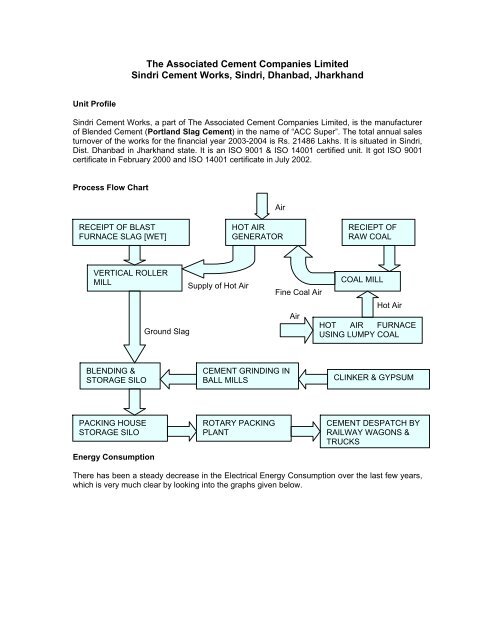
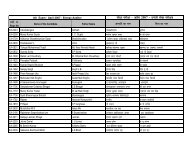
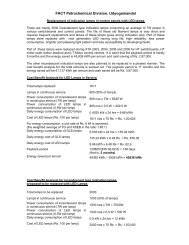
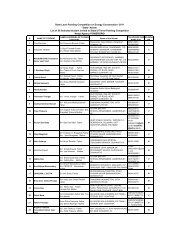
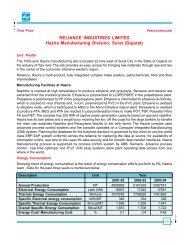
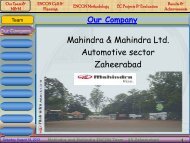
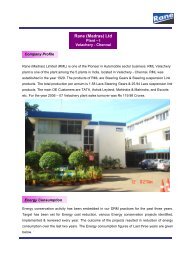
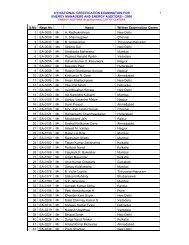
![Armstrong-Utility Soluitions [Compatibility Mode] - Energy Manager ...](https://img.yumpu.com/15315503/1/190x146/armstrong-utility-soluitions-compatibility-mode-energy-manager-.jpg?quality=85)
